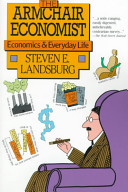Finance:The Armchair Economist
 | |
| Author | Steven Landsburg |
|---|---|
| Country | United States |
| Language | English |
| Subject | Economics |
| Publisher | The Free Press |
Publication date |
|
| Media type | Print (Hardback, Paperback) |
| Pages | 241(1993), 336(2012) |
| ISBN | ISBN:978-0-02-917776-1 |
| OCLC | 32900184 |
The Armchair Economist: Economics and Everyday Life is an economics book written by Rochester professor of economics Steven Landsburg. The first edition appeared in 1993. A revised and updated edition appeared in May 2012. The underlying theme of the book, as Landsburg states on the first page, is that "[m]ost of economics can be summarized in four words: People respond to incentives." With this apparently innocuous observation, Landsburg discusses some unexpected effects of various policies such as automobile safety legislation and environmental policies. The rest of the book includes expositions on a wide range of topics, including budget deficit, unemployment, economic growth, and cost–benefit analysis.
Chapter 4 covers the "Indifference Principle".
Chapter 9 covers the Coase Theorem of professor Ronald Coase.
The book is also recommended reading by the departments of economics at several universities.[1]
Background
Landsburg received a Master of Arts degree from the University of Rochester in 1974, along with a Doctor of Philosophy degree from the University of Chicago.[2] The now Rochester Professor of Economics released his first book, Price Theory and Applications in 1989 and followed it up in 1993 with the first edition of The Armchair Economist.[3] Since then he has written for many different publications such as Slate, The Wall Street Journal as well as releasing numerous other books surrounding the topic of Economics.[3][4]
In 2012 Landsburg released a "revised and updated" version of the original work, aiming to present the same ideas within a 21 century context. He achieved this by rewriting some chapters while also adding over 80 pages bringing the book into the contemporary age.[5][6]
See also
- Freakonomics
- The Undercover Economist
References
- ↑ "About Economics". University of Texas at Austin. Archived from the original on 30 September 2012. https://web.archive.org/web/20120930000803/http://www.utexas.edu/cola/depts/economics/Undergraduate/Prospective%20Students/About-Economics.php. Retrieved 2012-09-24.
- ↑ "An Interview With The Armchair Economist, Steven Landsburg". Region Focus 29: 46–52. March 2013. https://www.cis.org.au/wp-content/uploads/2015/04/images/stories/policy-magazine/2013-autumn/29-1-13-steven-landsburg.pdf.
- ↑ 3.0 3.1 "Books by Steven Landsburg | Book Depository". https://www.bookdepository.com/author/Steven-Landsburg.
- ↑ "Steven E. Landsburg | HMH Books" (in en). https://www.hmhbooks.com/author/Steven-Landsburg/61659666.
- ↑ "Editions of Armchair Economist: Economics & Everyday Life by Steven E. Landsburg". https://www.goodreads.com/work/editions/97811-armchair-economist-economics-and-everyday-experience.
- ↑ Landsburg, Steven E. (2012) (in en-us). The armchair economist : economics and everyday life (First Free Press trade paperback ed.). New York. ISBN 978-1451651737. http://www.armchairecon.com/. Retrieved 6 May 2023.
 |

